When I graduated, the first place I sent my resume to was Loizeaux Freres, in Towson, Maryland – about a half hour bicycle ride from my house. I believe I said something stupid in my cover-letter about how computerized process control was the way of the future and blah blah blah.
I got back a letter explaining that they mostly hire family, and what they do is serious stuff and they don’t hire entry-level positions. “Thank you.”
Loizeaux are the family that started Controlled Demolition, Inc. (CDI) – the company that invented the idea of using cutting charges and carefully planned explosions to collapse structures into their own footprint, quickly and safely. Building implosion, of course, got a bunch of mis-attention after the attack on the World Trade Center in NYC, Sept 11, 2001. There were ignorati who claimed that the buildings had been imploded using demolition techniques; I have no idea where they came up with that fanciful theory but it certainly didn’t emerge from any deep knowledge about demolitions. During the years after, while interest in the topic slowly died down, nobody seems to have asked the folks at CDI, or they declined to talk. First thing you need to know: what CDI does is very technical, very precise, and you don’t just decide you’re going to learn how to implode a building. They have been doing it – and are more or less the worlds’ only experts doing it – since 1947.
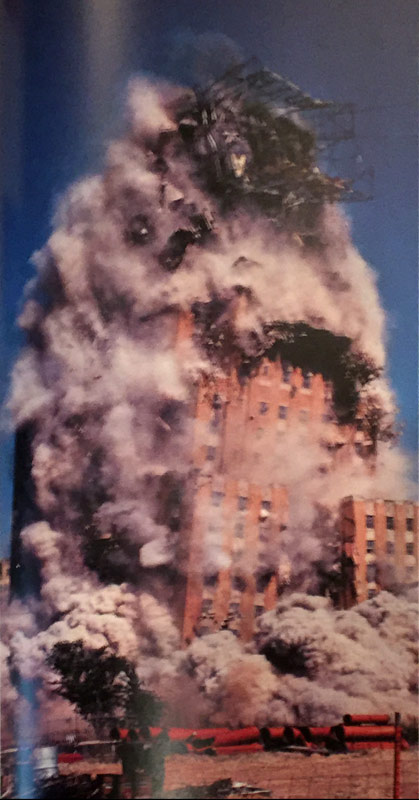
Peak moment of collapse
These scans* are from a book I bought back in 2000 called “Demolition” – it’s full of pictures of things being imploded. It is, understandably, scant on technical details. But it’s full of “gee wow numbers” that are more than somewhat relevant to any theory that the WTC collapse was a result of explosive implosion.
The picture on the right shows a building just after the charges have all gone off, and gravity is beginning to slump it down into a heap of wreckage. In order to do that, many charges are emplaced, so that the various main supports are all blown with extremely careful timing. The innermost supports go first, then the outer ones, so that gravity begins to pull the building together around its core, and – a half second later – the outer supports are blown so that the pieces, now separated, can fall inward and the whole building pancakes.
In some places, CDI plants cables around supports, chained around inner beams, to make sure things fall the correct direction; this is exactly the same technique lumberjacks use to keep a tree from kicking in the wrong direction – which reminds me, next time I see him, I’m going to ask the lumberjack up the street what he thinks of dropping a 60-story building compared to a 50-foot pine tree.
If you look closely at the picture you can see some parts where dust and debris have been blown from the building (about halfway down) compared to the roiling clouds of dust propelled by the air being driven out of the building as it collapses (bottom). You can also see that the outer shell of the building is mostly preserved; it’s just brick and stuff and that’s not going to support any of the weight of the falling mass.
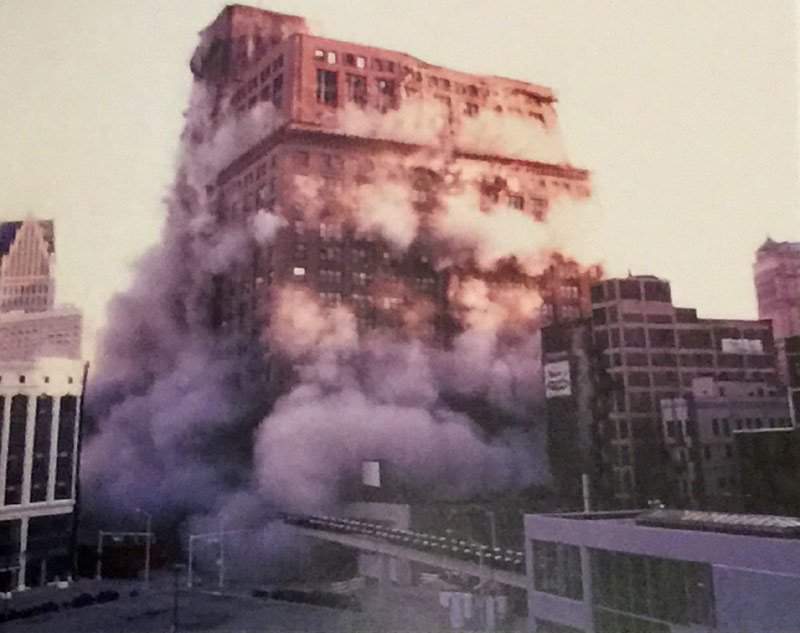
Here’s another one. You can see that there are 4 tiers of charges (including the bottom, now hidden by collapse-dust) that broke the floors of the building apart, and it’s already starting to pancake in on itself.
Now, let’s talk about some “gee wow numbers”
The Biltmore Hotel was built in 1932 with heavy beams and reinforced steel columns. By 1977 it stood in the way of a $39-million urban renewal plan to construct a cultural and recreational complex.
The Biltmore presented a challenge because of the heaviness of the steel; each 16-inch steel column with build-up flanges weighed in at 2.5 to 3 tons per floor. A single charge was insufficient to completely penetrate the thickness so, as a result, each 3-inch thick stem plate had to be attacked from both sides. In order to be successful it was imperative that the charges on the opposing sides go off simultaneously – if one went off too soon it would dislodge the other before cutting through the steel.
Nine-hundred ninety-one separate charges, approximately 800 pounds of explosives, were placed on seven floors from the basement to the 14th floor and detonated over a 5 second span. The building was dropped in a “controlled progressive collapse” that laid it out in such a way as to ease removal of the debris.

The Biltmore drops. 800 pounds of charges, 9061 separate detonation points
Nine hundred ninety one charges. Plus, each charge, to get the timing correct, would have electrical and detonation cord (“det cord”) runs to synchronize them at the control panel. As the nice people at CDI might have told ambitious Marcus back in 1985, computers aren’t as reliable as wire.** It had to be the devil’s own spiderweb in the building, and it was. You can see the dust cloud emerging from where the main supports were cut, the height of the entire building.
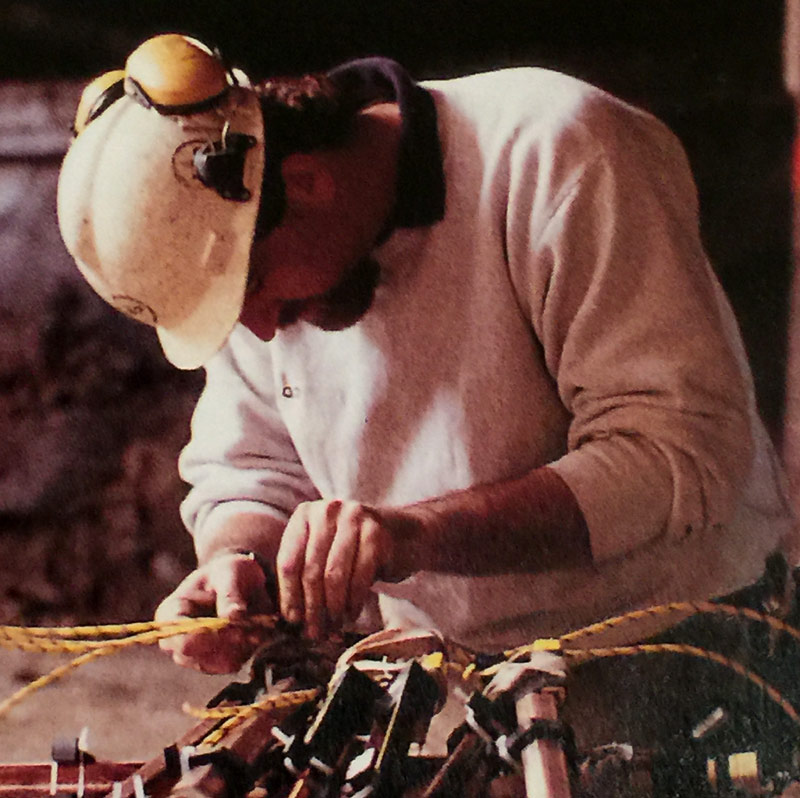
One does not simply “run det cord” – it’s high explosive, too.
Det cord is high explosive (filled with PETN) and explodes at a speed of 4 miles per second. Its explosion is not going to cut steel beams but it’s usable for minor demolition in its own right. A former military friend, who had done some explosives and ordnance disposal (EOD) said they used to cut down trees by wrapping a couple loops of det cord around them, then firing them. Timber!
The Loizeaux book doesn’t talk about this part but I have to assume that there are master control-points that are electrically fired from a synchronizing deck, which are laced together with det cord. I’d bet there’s some redundancy there: you might have 2 electrically-fired detonators to a floor at opposite ends of a lacing of det cord.
This is not trivial planning: someone has to sit there and figure out the blast sequence, then design the runs, figure how to provide redundancy, factor in failure modes, where the wires are going, etc. “Redundancy” is a really interesting problem when what you’re building is going to explode and destroy itself.
Let me just give you a simple example of the kinds of problems the demolition team has to solve, perfectly: if you’re blowing the main supports in the lower floor of a building, you need to make sure that the collapsing supports aren’t going to interfere with your wires or det cord that’s going to trigger the next set of explosions a couple flights up. If the building starts to shift and your wire grounds out, the entire building could fall sideways instead of into its own footprint. If your det cord is positioned so that a piece of concrete from an earlier explosion comes and knocks into it, it might cause a misfire of a whole explosive chain. CDI has been doing this since 1947 and as far as I can tell, they haven’t made a mistake, yet, that anyone has detected. As a professional who thinks in terms of risk analysis and failure modes, I’m in awe of them.

detcord to collapse a wall during stadium shot
This is what the det cord lacings look like; there are explosive charges behind that black tarp (when you’re wiring a building to explode, it takes weeks – and you have to worry about rain, squirrels, urban explorers, all kinds of things) It appears that the explosives are on the other side of some chain-link fencing. Remember: when high explosive goes off, rocks are basically cannon-balls. Slowing and directing explosions is an art-form here. They do careful tests on parts of the building, first; I didn’t include any pictures of that, but they will test-blast a support and see how much it takes, how much debris it throws, etc.
If you look at the picture, you’ll see – on the right hand side – what appears to be two “rails” of det cord leading to downward runs of det cord connected to the charges. On the off chance that one rail breaks or doesn’t fire, there’s what amounts to a circuit of high explosive.
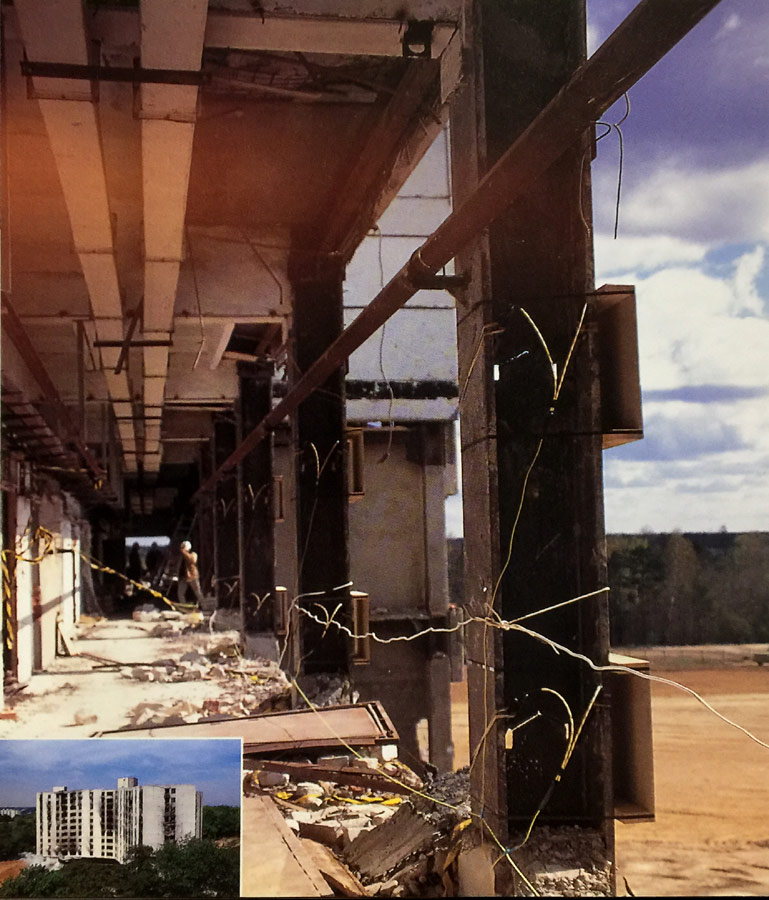
det cord on i-beams
Here we see I-beams rigged with cutting charges.
There’s a plywood shelter over each charge, presumably to keep rain, debris, etc, off it for the fraction of a second it needs before it explodes. Again, we see two “rails” of det cord, tied together.
Another important point comes up, now that we can look at the I-beams rigged to blast: you have to put the explosive against the metal. Explosions are subject to the inverse-square law*** – mostly – if you’ve got dead air between the explosion and the object, the explosion has to push the air between itself and the object, and high explosive gets its power from the tearing effect of the matter getting hit with a supersonic shockwave. That’s why “spaced armor” is still used in some armored vehicles – if someone is firing explosive shaped charges at you, they won’t hurt you (as much) if they go off while there’s dead air-space between you and them.
If you were doing a demolition of the World Trade Center you’d be in there hammering through drywall and plaster, tearing out ceiling panels, beating through light concrete, etc – so you could plant your charges where they’d actually do something: up against the metal supports. If you just strapped a cutting charge around a support clad with drywall and stud-work, you wouldn’t hurt the beam – you’d make an amazing mess when you exploded drywall all over the place, but that’s about it. Also: there is no alternative to this – you can’t use two charges, one to blow the plaster and drywall, and another to get the beam – because the first charge would disperse the second charge before it fired.
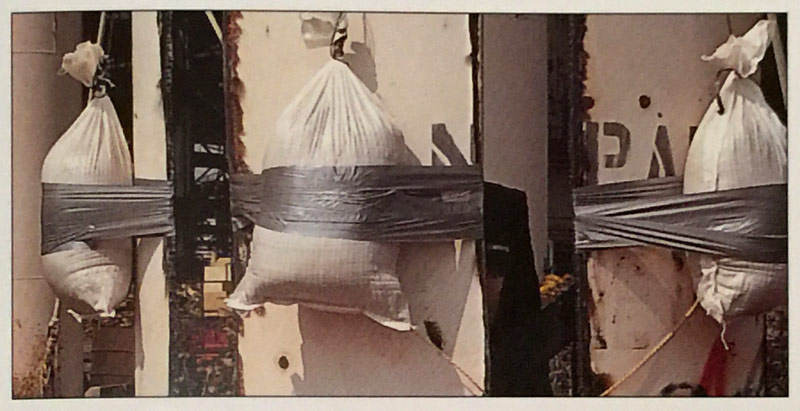
Sand bags on shaped charges
So, you get: bags of sand strapped against exposed steel beams, with shaped cutting charges underneath them. And, of course, det cord.
Can’t you picture all those office workers in the World Trade center, walking around for days while the demolitions experts hammered through drywall and plaster, duct taping shaped charges and hanging sand bags, then stringing multi-rail detcord across the tops of the cubicle farms? Maybe they wouldn’t have placed as many charges as for the Biltmore job, but there’d be hundreds of holes in walls, everywhere, on at least 6 floors, with det cord and wire and probably a few “High Explosives, Do Not Touch” warnings.
They didn’t sneak in overnight. More from the book:
Demolition of this structure proved to be a complex undertaking. It had been constructed in 13 stages over the course of 35 years, contained 33 different levels; blueprint drawings were no longer available, further complicating the task of structural analysis. Hudson’s was bordered on four sides by streets filled with critical infrastructure and flanked on three sides by poorly maintained turn-of-the-century structures with huge windows that occasionally broke in high winds. Detroit’s elevated “People Mover” was located just 15 feet from the structure.
Controlled Demolition, Inc. had to sever the steel in the columns and create a delay system that could simultaneously control the failure of the building’s 13 different structural configurations, while trying to keep the hundreds of thousands of tons of debris within the 420 foot by 220 foot footprint of the structure. It took 21 workers 3 months to investigate the complex and four months to complete preparations for the implosion design.
The columns of the building, each weighing over 500 pounds per foot and containing steel flanges up to 7 1/4 inch thick, proved yet another challenge. Once steel plates were removed with cutting torches, the remaining steel was cut using smaller charges – a technique intended to reduce the chance of damage to neighboring windows.
The 12-person loading crew spent 24 days placing 4,118 separate charges in 1,100 locations. Over 36,000 feet of detonating cord and 4,512 nonelectric delay elements were installed in the initiation system to create the 36 primary implosion sequence and 216 micro-delays, which would reduce the pressure created from detonation of the 2,728 pounds of explosives.
See why I call them “gee wow numbers”??
Oh, just by the by, the World Trade Center construction specs are available. The buildings had a core support of steel and an exterior support of steel, as well. 60 perimeter columns around the building and 47 columns defining the core. There was a lot of steel. There was a lot of plaster and drywall over that steel. And, at 93-99 floors up, it’d sure suck to be the guy having to duct tape cutting charges and sandbags on the outside of those beams. Or something. Gosh, darn, how did they do that?

World Trade Center “bathtub” base construction
Look at the wee little crane down there!! Some people appear to believe that the World Trade Center was deliberately imploded. So, all those office workers just stood around for weeks while the demolition crew hammered away and strung det cord, hauling endless pallet-loads of explosives up the freight elevators. Which, by the way, was “a thing” – I did a consulting gig in 1998 for Cantor Fitzgerald, and I was in their data center up near the top of the WTC. Why was the data center up at the top, and the offices lower down? Because, to get all the way up, you had to disembark from your elevator and get into another elevator that went the rest of the way. The elevator transfer, and the wait, apparently drove the stock traders nuts, so the trading room floor was lower down – right where the plane hit. When I was there, I was gobsmacked by the Rodin sculpture of “The Thinker” in the lobby. Torn chunks of bronze from it were found during the debris removal.
The elevators were always crowded. Including the freight elevators. Apparently there was a schedule you had to get on, if you were going to do more than a load of stuff in the freight elevator; there was a guy who made sure nobody blocked the freight elevator because there’d be fist-fights. I’m sure nobody minded that the freight elevator was blocked “in use by demolitions crew” for days while they hauled their nefarious loads up and down.
Conspiracy theories depend on “motivated reasoning” a form of confirmation bias where the person accepts as true information that supports what they already believe, and they don’t look beyond their simple theory to encounter evidence that might show how wrong it is. The idea that the World Trade Center was deliberately imploded is utterly ridiculous if you know anything at all about demolition. The conspiracy theorists learn just enough to be wrong and stop there. It’s a bummer, because demolition is fascinating engineering and – in the hands of CDI – it’s an art-form.

I think I’ve belabored the basic point enough, so let’s talk about some more fun stuff. One of the other things CDI has branched out into doing is pyrotechnics. For “Lethal Weapon” they imploded a building in Orlando, Florida:
A big piece of the fun was that CDI placed pyrotechnics into the control loop. I assume they went off before the high explosives, or the pyrotechnics would have just blown out and vanished in the shockwave – a nifty bit of work in its own right.
Since then, CDI has taken to doing more pyrotechnic-enhanced demolitions, including The Sands Casino in Las Vegas, and other buildings where they had the space to safely vaporise bottless full of diesel fuel using det cord, then fire igniters, and then the high explosive. It’s beautiful only because it’s safe.
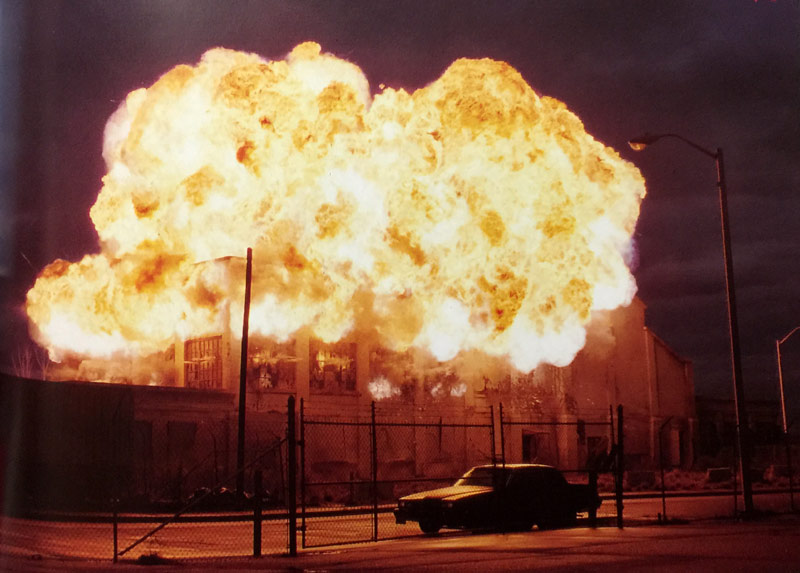
Stand back
Last, but not least, CDI was hired by the Hungarian Government to dispose of old war-gear from the Soviet era. Specifically SCUD missiles, launchers, warheads, etc. They hauled them out, ran the det cord and placed the diesel, and the people of Hungary got their money’s worth:
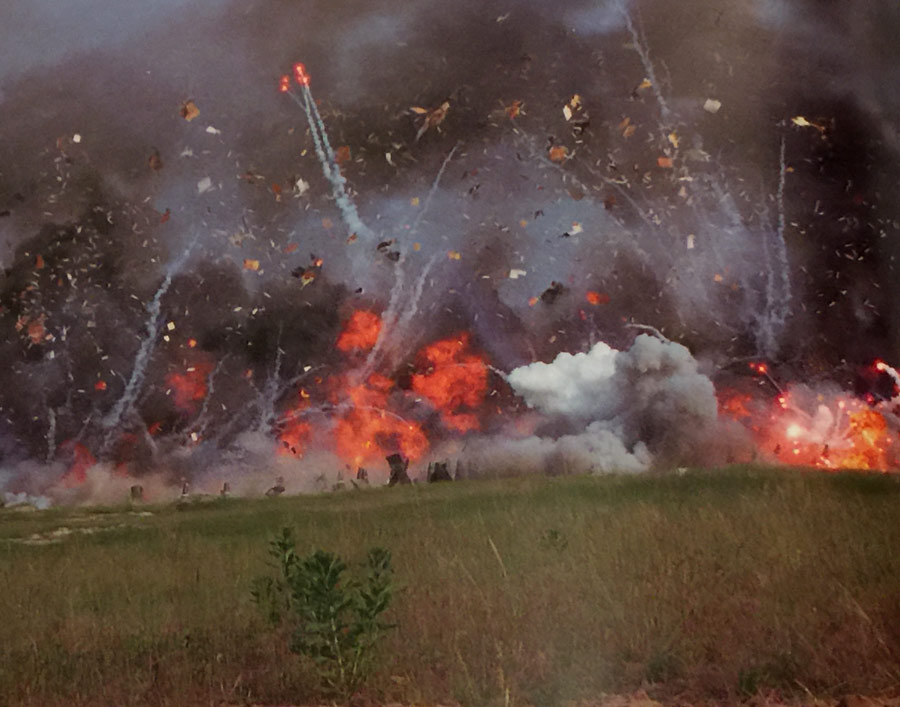
How missiles should be used
Those funny shredded looking things? Those are trucks.
I used to play a game called “Demolition Master” on my iPad when stuck in airports, but then I realized that might be a bad signal to send. It’s an insanely simplified view of demolition but it’s still hard.

Demolition at Amazon
(* Actually I shot them with my iPhone and resampled and skew corrected them in photoshop)
(** Less ambitious, more scarred, and somewhat wiser Marcus – having worked in information security for 30 years, hopes that CDI is still using wire and not computers!)
(*** “Assume a perfectly spherical blast-wave” – as the blast wave increases its size its energy goes down, approximately in accordance with the surface area of a sphere.)
If you’re a fan of the BBC “Witness” podcast, there’s an episode interviewing Philippe Pettit about the twin towers highwire walk he did, which includes some interesting details about elevator security at WTC.

Partly to yank the chains of 9/11 troofers, I posted this Salon article about new blast/fire-resistant construction methods on a political listserv.
The yankage worked: I got a literal LOL from the guy who denounced the report of new techniques to reinforce concrete, etc, with “this is a conspiracy theory.”
CDI’s next generation will face even tougher challenges. How long until they have to start taking down buildings by ramming jetliners into them?
Fascinating. I used to work with dynamite; we called that stuff “primer cord” not det cord but seems like it’s the same stuff. Absolutely incredible how CDI has that all so well timed. Free tip, when working with dynamite: DO NOT get that stuff on your skin. You will get the worst headache ever if you do.
On conspiracy theories… ever try and get 5 people to decide what to get on a pizza? Yeah. One of the reasons I find them so hard to believe in. I realize that every now and then someone manages to pull one off but damn it can be hard to get people to cooperate.
I was at first astonished by this — one of the most famous sculptures in the world was destroyed in 2001? But then I hit WikiP, and found that there were multiple castings of the sculpture, in different materials (plaster, bronze, and plaster with bronze coating/painting), and even different sizes (original vs monumental), by different foundries/studios, so there are still at least a couple dozen versions of the sculpture still in existence. The WTC casting seems to have not even been a particularly early one.
But WikiP also links to an NYTimes piece that says that the World Trade Center casting of “The Thinker” survived, but disappeared afterwards, FWIW. There were other sculptures at the WTC, and the linked article describes some of them, so these may well have resulted in the bronze fragments found.
They blew up Hudson’s? Hudson’s?
I’ve had the dubious privilege of seeing CDI demolish two buildings. The precision of the result was incredible. The months taken to prepare and the work undertaken was also pretty noticeable. Even preparation for a quick and dirty explosives demolition couldn’t possibly go unnoticed or remarked upon. Note the use of stop piles. Also, the Police Station was supposed to do a two step collapse and topple in order to consolidate the debris in a tight, easily broken up pile.
… I’m going to ask the lumberjack up the street …
Also please ask him if he’s OK.
Those funny shredded looking things? Those are trucks.
Do Hungarians have so many surplus trucks they have to get rid of them through explosive demolition?
Thank you for this, Marcus. This was extremely informative and timely, because I definitely feel like blowing shit up today. Does Amazon sell det cord?
Pierce R. Butler@#6:
The trucks were old SCUD missile carriers/erectors. They’d have been useless for anything else. Boom!!
Iris Vander Pluym@#7:
You can buy det cord if you meet certain not very stringent requirements. Warning: unsettling right wing gunfreak content
Owlmirror@#3:
When I saw “The Thinker” in the lobby, I was surprised, too, and that was when I learned that there are usually a fair number of editions of great art-works. Including Rodin’s. The museum in Paris is a favorite place of mine… highly recommended.
Some art, such as Ansel Adams photographs, has been thoroughly debased when they started allowing “limited edition” prints (limited to thousands) from Adams’ negatives. Art, supply, demand, you know…
kestrel@#2:
DO NOT get that stuff on your skin. You will get the worst headache ever if you do.
Interesting!! Toluene used to be in a lot of spray paint, and I had some popskull headaches from that. I wonder if that’s what’s happening.
Dynamite is nitroglycerin soaked into a special type of clay. Nitroglycerin is absorbed through the skin, and is a strong vasodilator. It’s used in the treatment of angina pectoris (chest pain caused by heart disease). It’s fast-acting and very effective at decreasing blood pressure, but headache is a very common side effect.
Then, of course, there’s the problem that all of your carefully-rigged explosives have to still work perfectly after somebody’s slammed a jet liner into them and let the whole lot burn for an hour, not to mention the non-trivial challenge of getting the plane to hit the floor where you’re going to start the collapse…
cvoinescu@#12:
Dynamite is nitroglycerin soaked into a special type of clay. Nitroglycerin is absorbed through the skin, and is a strong vasodilator
Arrrgh! Teach me to do my comment review and follow up after a day sitting on airplanes! You’re completely correct – I was brain’o’ing and confused TNT for dynamite. (I believe the clay is diatoms!) And since I was barking up the wrong tree ‘o nitrates, of course I forgot the vasodilator effect. Thanks for the correction!
Dunc@#13:
Then, of course, there’s the problem that all of your carefully-rigged explosives have to still work perfectly after somebody’s slammed a jet liner into them and let the whole lot burn for an hour, not to mention the non-trivial challenge of getting the plane to hit the floor where you’re going to start the collapse…
Clearly, nothing is beyond THEM.
The last time I got into the whole blasting/implosion thing with a truther, it wound up with him hypothesizing that THEY had invented whole new forms of blasting technique (and presumably successfully tested them on the first hot run)
I though the whole argument for implosion was because there was actually no plane that hit, or something. It’s very hard for me to understande exactly what the conspiracy is all about, and why anyone would go to so much effort when it’d be much easier for the conspirators to fly an airplane full of people into a building.
My favorite Truther explanation of how the WTC towers were brought down is that they used “nuclear shaped charges”. WTF is a “nuclear shaped charge”? They might have said thromblebangers and pixie dust and it would have been as illuminating and credible.
Well, that’s one of the great things about conspiracy theories (in fact, arguably one of the defining traits) – they don’t need to be internally consistent, or agree on the details. As long as everybody agrees there was a conspiracy of some kind, people who believe wildly different and contradictory things can get along just fine, and if need be, the details can be changed depending on what argument you’re trying to deflect at the time.
You were just ahead of your time. Most of the industry uses programmable detonators. You program each detonator and tell at whic MS it should detonate. I don’t think CDI uses it but they are technological Luddites in the blasting industry. They haven’t mastered PowerPoint and their website hasn’t been updated since the 90’s. Here’s the info on the detonators
http://www.dynonobel.com/~/media/Files/Dyno/ResourceHub/Brochures/North%20America/SmartShot%20Brochure%20Underground.pdf
George@#18:
I guess with GPS, we’ve got reliable enough clocks to synchronize darned near anything to a high enough degree of accuracy for most purposes. That looks like some fun tech.
I’m hesistant to say what’s luddite and what’s conservative engineering. The last 30 years of watching software evolve hasn’t made me very confident.